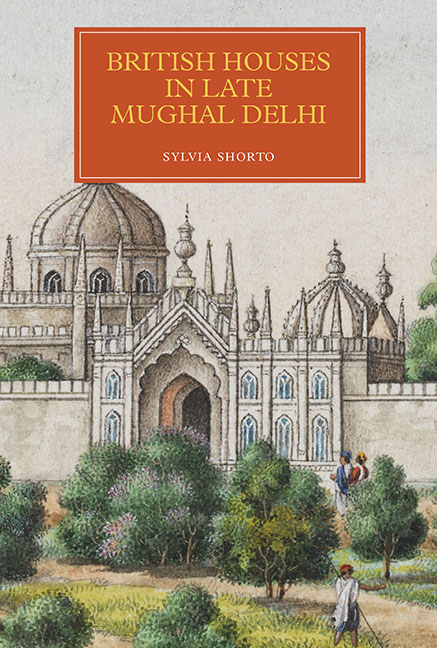Book contents
- Frontmatter
- Dedication
- Contents
- List of Illustrations
- Preface and Acknowledgements
- Abbreviations
- Glossary
- Map
- Chapter 1 Knowledge of Delhi: The Eighteenth Century
- Chapter 2 Hybrid Accommodations: David Ochterlony, the First Residency and the Mubarak Bagh
- Chapter 3 A Lovely Wilderness: Charles Metcalfe and the Garden Houses at Shalimar
- Chapter 4 Truly Fairy Palaces: Robert Smith in Delhi and in Europe
- Chapter 5 The World Displayed: William Fraser and his House on the Hill
- Chapter 6 A Tomb with View: Thomas Theophilus Metcalfe's Dilkusha
- Chapter 7 Dreaming of Home
- Bibliography
- Index
- Miscellaneous Endmatter
Chapter 6 - A Tomb with View: Thomas Theophilus Metcalfe's Dilkusha
Published online by Cambridge University Press: 07 July 2018
- Frontmatter
- Dedication
- Contents
- List of Illustrations
- Preface and Acknowledgements
- Abbreviations
- Glossary
- Map
- Chapter 1 Knowledge of Delhi: The Eighteenth Century
- Chapter 2 Hybrid Accommodations: David Ochterlony, the First Residency and the Mubarak Bagh
- Chapter 3 A Lovely Wilderness: Charles Metcalfe and the Garden Houses at Shalimar
- Chapter 4 Truly Fairy Palaces: Robert Smith in Delhi and in Europe
- Chapter 5 The World Displayed: William Fraser and his House on the Hill
- Chapter 6 A Tomb with View: Thomas Theophilus Metcalfe's Dilkusha
- Chapter 7 Dreaming of Home
- Bibliography
- Index
- Miscellaneous Endmatter
Summary
Despite the aftershock that resulted from the murder of William Fraser in 1835, the British East India Company had now entered into a period in which its supremacy in Delhi, on the surface at least, seemed unruffled. It appeared to be on a secure and prosperous footing. But was this really the case and, if so, to what degree was this apparent stability maintained by fine-tuning the continuing links between the public behaviour of British officials and the conventions of the Mughal nobility? Did these behaviours change at all? To attempt an answer, I examine the houses of the long-serving Company official Thomas Theophilus Metcalfe (1795–1853), William Fraser's successor in the office of Agent and Commissioner at Delhi, as the post of Resident had come to be known. Metcalfe, operating just behind the facade of Mughal sovereignty, occupied the post from 1835 until his death, for such a long time that he was popularly known as the ‘King of Delhi’. His building activities can be understood as the manifestation of the hegemonic position he now held over both Delhi's British and its Indian society.
The British had settled themselves on top of extant Mughal urban fabric in many parts of north India, and we have seen in previous chapters how parts of prominently sited princely palaces, baradari and other elite indigenous domestic building types inside the walls of Shahjahanabad had been reused. So had Shahjahani and later Mughal pleasure gardens, both imperial and sub-imperial, in the well-irrigated areas outside the walls to the north and west of Delhi. We have also seen how the local conventions of building for the hot climate of the northern plains had been adapted in variations of the competing classical and Gothic styles of the home culture. There are also a number of well-documented examples of the appropriation of sacred monumental structures for domestic use, occasionally mosques but more frequently the tombs of the lesser Mughal nobility – tombs that were compact in size and generally set in open, formally planned, enclosed gardens.
In this chapter I analyse the meanings of Thomas Metcalfe's appropriation of the octagonal tomb of an early-seventeenth-century Mughal nobleman, Muhammad Quli Khan, near the urban village of Mehrauli, which, by 1844, Metcalfe had begun to convert into a small country retreat.
- Type
- Chapter
- Information
- British Houses in Late Mughal Delhi , pp. 139 - 174Publisher: Boydell & BrewerPrint publication year: 2018

